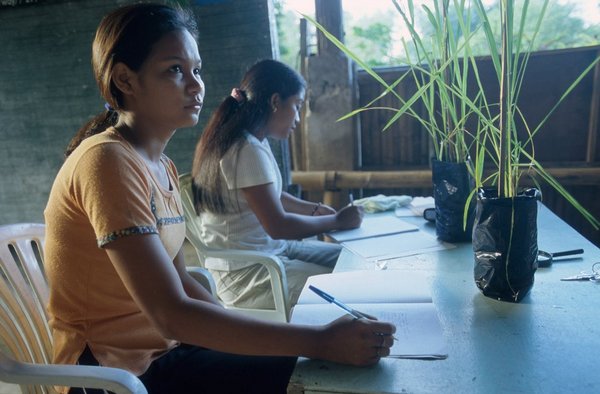- Share this article
- Subscribe to our newsletter
Creating employment for rural youth
For a long time, rural youth – and rural areas in general – represented a niche topic in international cooperation. However, this has changed since the “G20 Initiative for Rural Youth Employment” was launched at the G20 Summit in Hamburg/Germany in July 2017. The International Fund for Agricultural Development (IFAD) grasped the G20 Initiative as an opportunity to devote its 2019 Rural Development Report to the topic. The results of the report and their implications for international development cooperation were discussed at a joint event run by the IFAD and Germany’s Federal Ministry for Economic Cooperation and Development in Berlin/Germany.
The level of transformation matters
Paul Winters, Associate Vice-President of IFAD’s Strategy and Knowledge Department, presented some important facts and conclusions from the report. There are 500 million rural young people world-wide; if the semi-rural and peri-urban areas are included, the total even amounts to 780 million. Out of these, 20 per cent today live in sub-Saharan Africa (SSA) and 56 per cent in Asia and the Pacific; by 2050, 40 per cent are expected to be living in rural SSA Africa.
Generally, the majority of countries with large rural youth populations have a high rural poverty rate, depend heavily on agriculture and have the lowest capacity to deal with climate change. At the same time, according to Winters, fertility rates are highest in poor regions.
IFAD surveys have demonstrated that only little is known about youth economic activities. However, they clearly relate to the level of transformation of a country. Almost three quarters of rural youth live in countries with low rural transformation. Moreover, two out of three rural youth in developing countries live in areas with high agricultural potential. Whether they really take up activities in agriculture strongly depends on their parents’ household. “The country and the household dictate what they do,” Winters explained.
The triple challenge of young rural women
Being young, being rural, being female: young rural women continue to face a triple challenge. Take land ownership, for example. One in three rural people own land. But only every tenth young person does so, and only every twentieth young woman. Winters calls for urgent changes in social norms.
What has changed compared to in the past is the demands on young people’s capacities and skills, but also the opportunities that these aspects hold. For example, Winters explained, digitisation had enabled scale without mass. In education, at least just as much importance had to be attached to cognitive skills such as critical thinking and problem solving as to the technical skills. “Vocational training is not enough,” Winters stressed.
What can be drivers of growth?
“The key question for me is: Where do the markets come from?” said Tilman Altenburg, Head of the Transformation of Economics and Social Systems Programme at the German Development Institute (DIE). Trends like urbanisation, with their rising middle classes, could open up new markets which could be drivers of growth in agriculture. The substitution of fossil fuels or power supply for a growing number of households also held a considerable potential, especially with a view to possibilities off the grid.
Growth in cities generally offered a wide range of opportunities for economic development in rural regions, for example in the building sector, where the use of renewable materials was gaining ground. Here, there was a huge demand for rural natural materials. “The question is how to upscale innovative approaches,” Altenburg maintained. To him, nurturing entrepreneurship is crucial when it comes to job opportunities for young people.
Nothing will work without ICT
However, some of the audience pointed out that not every youth had the opportunity or ability to become an entrepreneur. What about the rural workers? Andrew Makatiani, a young “agripreneur” from Kenya, reminded the meeting that entrepreneurs were also creating jobs. “I have made agriculture my white collar job,” says chicken keeper Makatiani, who now also coaches other young people and has five employees, two of them professionals. However, he explained that he was working with several small entrepreneurs, also in the informal sector (which accounts for 85 per cent of the workforce in sub-Saharan Africa), who he hired, for example, to transport his chickens.
“Internet access in rural areas is a must,” the young entrepreneur maintained, explaining the preconditions for viable rural youth employment. When his enterprise had still been in the start-up phase, more than 50 per cent of his chicken had died. He found out the reasons for this in the Internet and, based on his new insights, developed his current business model. Makatiani believes that networks one can consult when problems crop up are far more important than financial support.
Urban bias in policy-making
There was agreement in the discussion that the solutions for rural youth could not be found solely in agriculture. Migration and remittances play just as important a role as rural-urban linkages in commodity value chains. Here, migration should be a choice, not a necessity, IFAD Vice President Cornelia Richter stressed. Richter warned not to overestimate the absorptive capacity of rural areas, especially in regions with scarce resources. Nevertheless, the urban bias that persisted in policy-making in many countries was a problem still to be solved.
Silvia Richter, Rural 21
Further reading:





Add a comment
Be the First to Comment